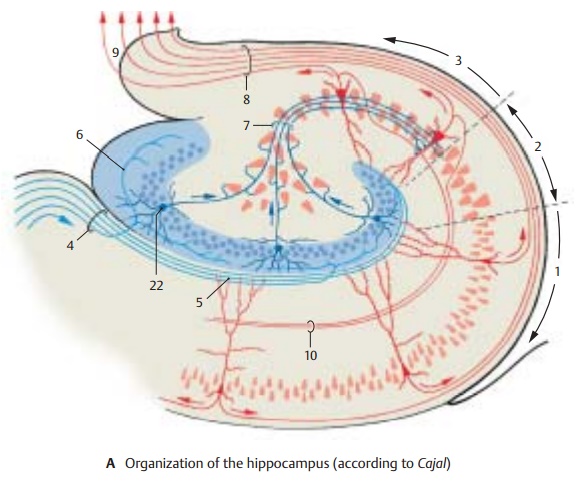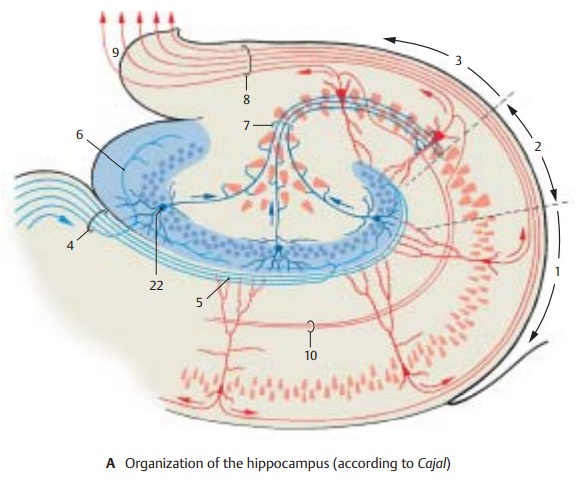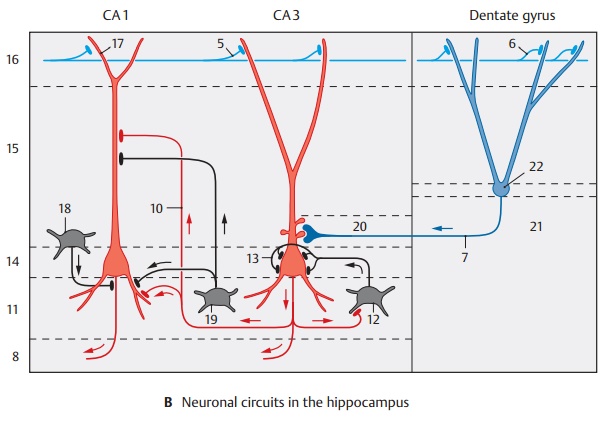Chapter: Human Nervous System and Sensory Organs : Telencephalon
Hippocampal Cortex

Hippocampal Cortex
The structure of the archicortex is simpler than that of the neocortex, and its neuronal circuits are therefore easier to elucidate. The hippocampal cortex belongs to those brain regions where inhibitory and excitatory neurons have been identified both histo-logically and electrophysiologically.

Fields CA1 (A1), CA2 (A2), and CA3 (A3) showdifferences with respect to organization and fiber connections. The majority of afferent fibers enter Ammon’s horn via the perforantpath (A4), and only a few do so via the alveusof hippocampus. They terminate on the dendrites of the pyramidal cells (AB5). Many of the fibers (AB6) extend to the granule cells (AB22) of the dentate gyrus (fascia dentata); their axons, mossy fibers (AB7), too, have synaptic contacts with the dendrites of pyr-amidal cells. However, mossy fibers run only to field CA3; they are absent from fieldsCA1 and CA2.

The pyramidal cells are the efferent el-ements; their axons collect in the alveus (AB8) and leave the cortex through the fim-bria (A9). The axons of the CA3 pyramidalcells give off recurrent collaterals (Schaffercollaterals) (AB10) that form synapses withdendrites of the CA1 pyramidal cells. The efferent fibers running to the septum origi-nate in CA3, the fibers for the mamillary body and the anterior thalamic nucleus originate in CA1. Many of the efferent fibers of the hippocampus, however, run to the subiculum.
Organization of layers.Ammon’s horn con-sists of the following layers: the alveus (AB8) with the efferent fibers lies inside and is followed by the stratum oriens (B11 ) with the basket cells (B12), the axons of which split up and fill the pyramidal layer with a dense fiber network (B13). The fibers en-velope the pyramidal cell bodies and form synaptic contacts (axosomatic synapses) with them. Basket cells are inhibitory neu-rons that are excited by the axon collaterals of the pyramidal cells and cause pyramidal cell inhibition following pyramidal cell dis-charge. The pyramidal cells form thestratum pyramidale (B14). Their apices areoriented toward the subsequent stratumradiatum (B15), their bases toward the stratum oriens. They send dense dendritictrees in both directions. The long apical den-drite reaches with its branches into the stratum lacunosum-moleculare (B16). In theCA3 region, one can also distinguish a stratum lucidum (B20) where the mossy fibers run.
The afferent fibers originating from different regions run in different layers. Many of the commissural fibers from the contralateral hippocampus extend into the stratum oriens (B11) and the stratum radiatum (B15). The fibers of the entorhinal area (B5) extend into the stratum lacunosum-moleculare (B16) and form contacts with the outermost branches of the apical dendrites (B17). Schaffer collaterals (B10) have contact with distal segments of the apical dendrites of the CA1 pyramidal cells, while the mossy fibers (B7) have contact with proximal seg-ments of the CA3 pyramidal cells. The den-drites of granule cells of the dentate gyrus are contacted in a similar way; entorhinal fibers terminate on distal dendritic seg-ments, while commissural fibers terminate on proximal segments of the dendrites. In addition to the principal cells—pyramidal cells and granule cells—the afferent fibers of the hippocampus also form synaptic con-tacts with inhibitory GABAergic inter-neurons (feed-forward inhibition of princi-pal neurons, p. 35, C). Apart from the basket cells mentioned above (B12), which form axosomatic synapses, GABAergic cells have been found in recent years that form synap-tic contacts on the initial segment of the axon (axo-axonal cells or chandelier cells) (B18) or on the dendrites (B19) of the princi-pal cells. From the course of the fibers and from electrophysiological studies, the fol-lowing impulse flow emerges in the hippo-campus: glutamatergic, entorhinal afferent fibers activate granule cells which, in turn, activate CA3 pyramidal cells via mossy fibers. These then activate CA1 pyramidal cells via Schaffer collaterals (trisynaptic ex-citatory pathway of the hippocampus).
B21 Hilus of dentate gyrus.
Related Topics